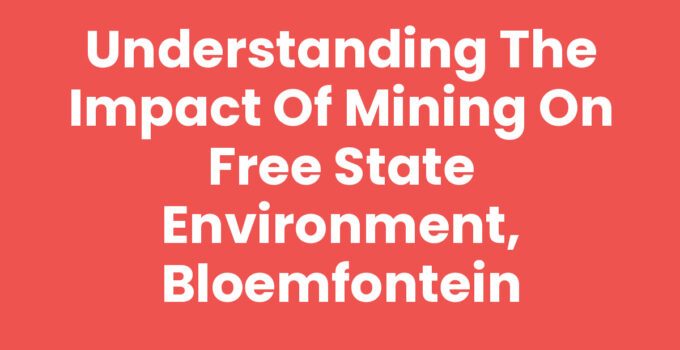The Free State province of South Africa, particularly Bloemfontein, has a rich history of mining that has significantly shaped its economic landscape. However, the environmental ramifications of mining are increasingly coming under scrutiny. In this blog post, we will extensively explore the impact of mining on the Free State environment, specifically focusing on Bloemfontein, assessing both its short-term and long-term consequences.
Impact of Mining on Free State Environment, Bloemfontein
Mining activities in the Free State have led to various environmental challenges, including land degradation, water pollution, and loss of biodiversity. Below, we break down these impacts in detail:
1. Land Degradation
The process of mining often involves the removal of topsoil, which leads to substantial land degradation. In areas surrounding Bloemfontein, mining operations have stripped away vegetation, disrupting local ecosystems and reducing biodiversity. Land that was once fertile has become barren and unusable, effectively diminishing agricultural productivity and the natural habitat for local flora and fauna.
2. Water Pollution
Mining operations frequently introduce harmful pollutants into nearby water bodies. The runoff from mining sites can carry heavy metals, sulfuric acid, and other toxic materials into rivers and lakes. In Bloemfontein, this has led to contamination of vital water resources, posing significant risks to human health and aquatic ecosystems. Safe drinking water sources are dwindling due to the encroachment of mining into these delicate water ecosystems.
3. Loss of Biodiversity
As mining destroys habitats, the native wildlife in Bloemfontein suffers greatly. Many species are forced to migrate due to habitat loss, which can create issues in genetic diversity. For instance, many plants and animals native to this region are endangered, and mining continues to eradicate their remaining populations. Conservation efforts are needed to restore and protect these species from further decline.
Mitigation Strategies for Environmental Impact
With the understanding of mining’s impact on the Free State environment, it becomes crucial to focus on mitigation strategies that can help lessen these effects:
1. Sustainable Mining Practices
Implementing sustainable mining practices is paramount. This includes adhering to environmental regulations and conducting environmental impact assessments (EIAs) before initiating any mining projects. Mines should also establish reclamation plans that prioritize restoring the land post-mining operations.
2. Pollution Control Measures
To combat water contamination, mining companies must invest in advanced pollution control technologies. This could involve the installation of water treatment facilities and the regular monitoring of water quality to ensure compliance with environmental standards.
3. Community Engagement and Education
It’s essential to involve local communities in discussions about mining operations. Educating the public on environmental issues stemming from mining can foster collective action towards sustainability and encourage local involvement in conservation efforts.
Conclusion
The impact of mining on the Free State environment, particularly in Bloemfontein, is profound and multi-faceted. As we continue to balance economic interests with environmental responsibility, it is crucial to advocate for sustainable mining practices and prioritize the health of our ecosystems. Addressing these challenges head-on will ensure a viable future for both the environment and the communities that depend on its resources.
Frequently Asked Questions
What are the main environmental impacts of mining in Bloemfontein?
Main impacts include land degradation, water pollution, and loss of biodiversity.
How can mining companies mitigate their environmental impact?
By implementing sustainable practices, pollution control measures, and engaging with local communities.
Is water pollution a significant concern in the Free State due to mining?
Yes, water pollution poses a serious risk to health and local ecosystems.



